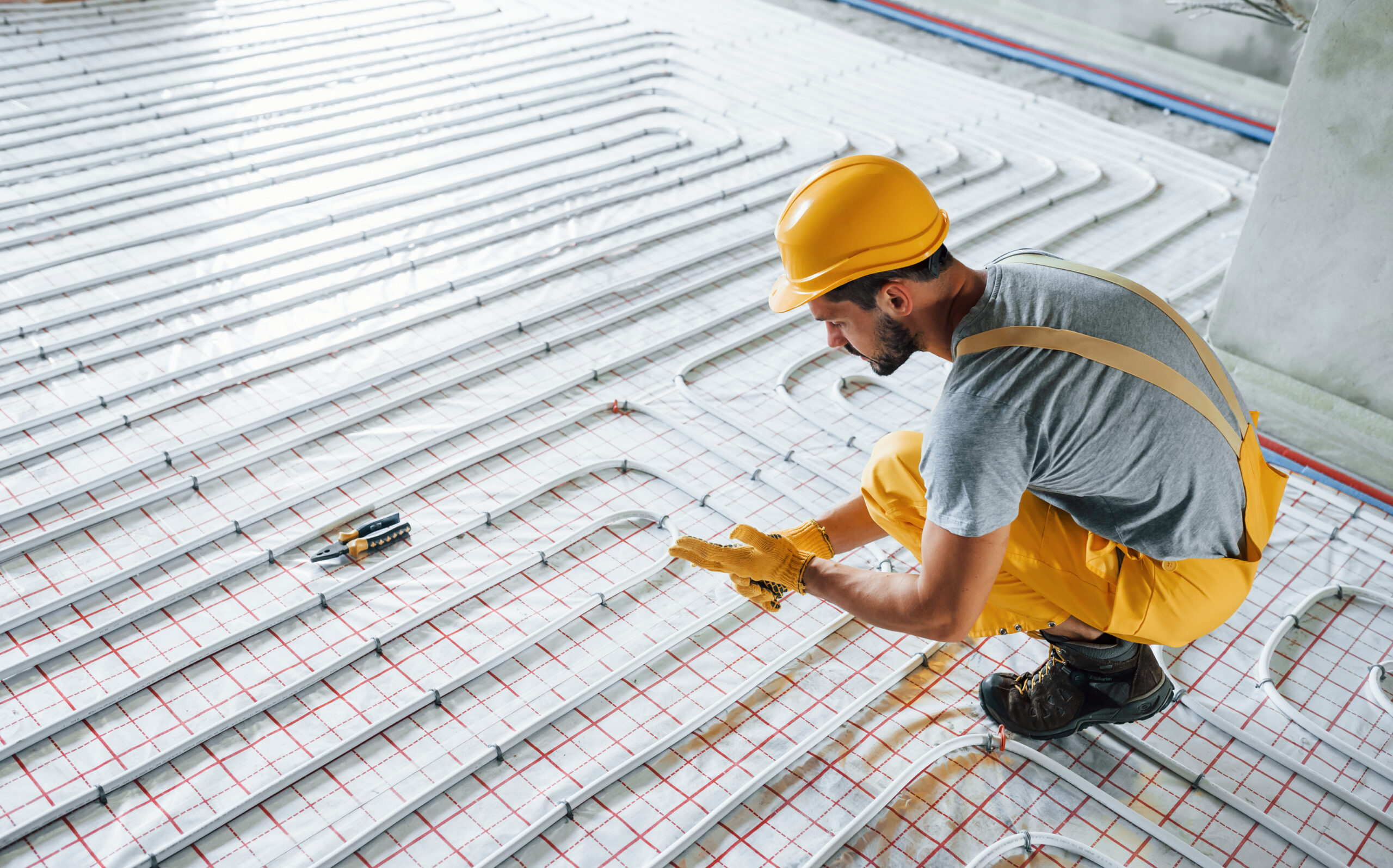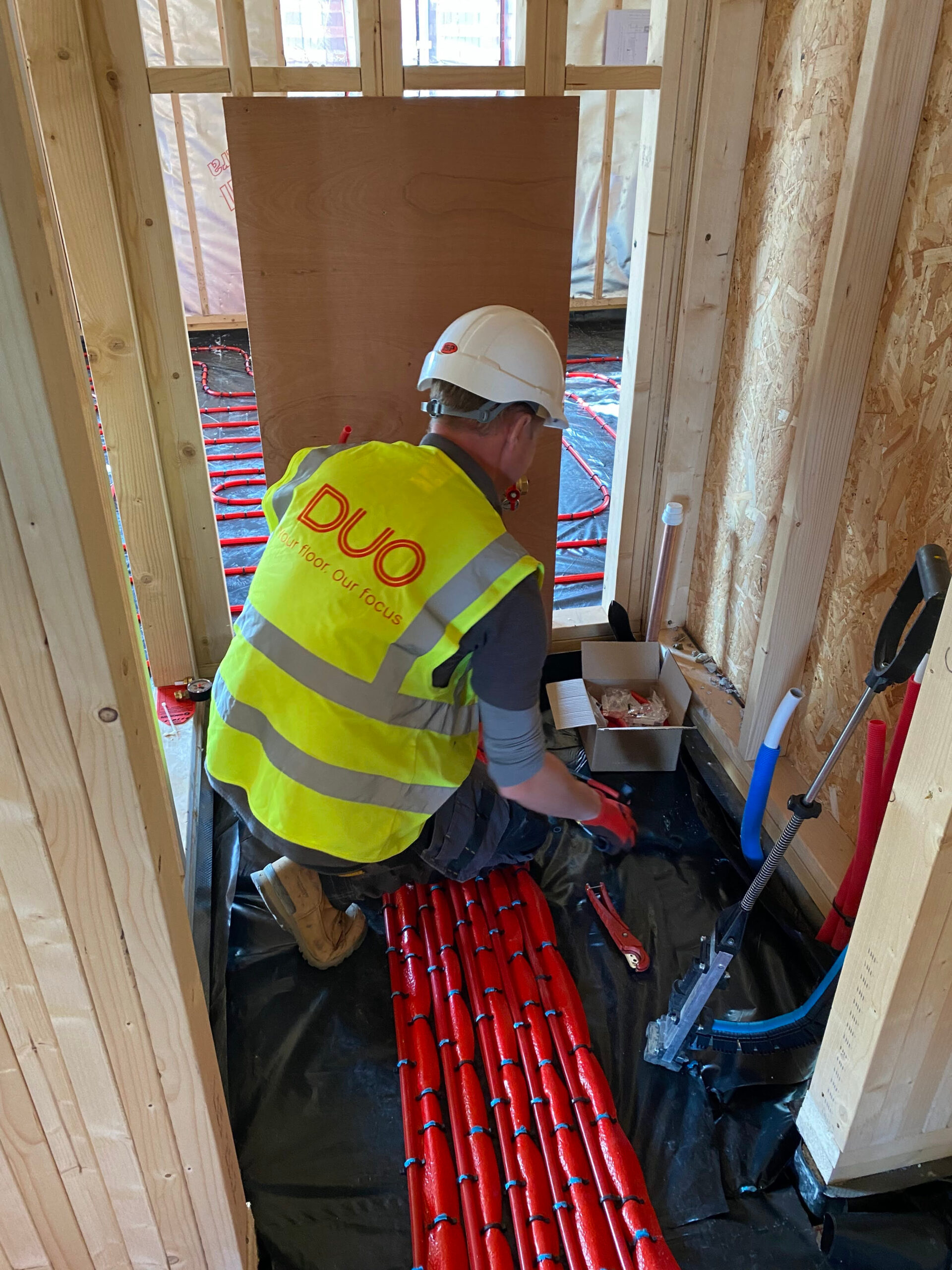If you’re asking, how does underfloor heating work, you’re not alone. More and more people across the UK are thinking about ditching traditional radiators and switching to this quiet, invisible and even heat source. But to make the right choice, you need to know exactly how the system works.
Underfloor heating works by gently warming the floor surface using either electric wires or a system of water-filled pipes beneath the floor. This heat then rises evenly, warming the entire room from the ground up. It’s an efficient and comfortable way to heat your home, without hot or cold spots. There are two main types: electric underfloor heating and wet (water-based) underfloor heating, and each has its own setup and benefits.
This guide will walk you through everything from how it works, to the pros and cons, installation factors, and maintenance needs. Whether you’re thinking about a full home renovation or just updating one room, it’s important to understand what you’re paying for and why it matters.
We’ll explain things clearly, using everyday language, so you don’t feel overwhelmed by technical talk. By the end of this article, you’ll know whether underfloor heating is right for your space, and you’ll be able to explain how it works to someone else.
Electric Vs Water-Based: How Does Underfloor Heating Work In Different Setups?
When asking how underfloor heating works, it’s important to first know that there are two main types of systems: electric and water-based. Each one operates in a different way and suits different types of homes and flooring.
Electric underfloor heating works by using heating cables or mats that are fitted just beneath the floor surface. These cables heat up when switched on, warming the floor and then gradually heating the room from the ground up. Because the system is thin and easy to install, it’s a popular choice for smaller areas or rooms being renovated. Electric systems heat up quickly, and they don’t take up any wall space like radiators do. However, they can be more expensive to run due to the cost of electricity, which is something to think about if you’re planning to heat a large area.
Water-based underfloor heating (also called wet systems) involves a network of pipes connected to your boiler or a heat pump. Warm water flows through the pipes beneath the floor, creating an even spread of warmth throughout the room. These systems are more efficient in the long term, especially when used with renewable heat sources like air source heat pumps. Because they run at lower temperatures than standard radiators, they are cheaper to run once installed.
The installation process for each is also different. Electric systems are less invasive, meaning they can often be laid on top of existing flooring or with minimal disruption. Wet systems, on the other hand, usually require more planning. They are often installed during major renovations or new builds because the pipework needs to be laid in screed or between floor joists.
Both systems work by warming the floor first, which then releases heat into the room in an upward motion. This leads to a more comfortable and even heat compared to radiators that heat the air near the ceiling first.
When comparing underfloor heating options, think about the space, your budget, and your long-term energy use. Electric is best for quick installations and small spaces. Water-based works well for whole-home systems and long-term savings. Both systems, however, will bring comfort and efficiency to your home when installed correctly.

Flooring Matters: Matching The Right Materials With Underfloor Heating
When exploring, how does underfloor heating work? One key part that often gets overlooked is the flooring you pair it with. The type of flooring in your home can affect how well the system works, how quickly it heats up, and how efficiently it holds on to heat.
Some materials are better at transferring heat than others. Tile and stone floors are the best match for underfloor heating. They are natural conductors, meaning they warm up quickly and spread heat evenly across the room. Once warm, they also hold on to the heat for longer, which helps you save energy and stay comfortable even after the system turns off.
Laminate and engineered wood are also good choices, but they need to be checked for compatibility. These materials can handle the lower temperatures that underfloor heating systems produce, especially water-based systems. It’s important to follow the manufacturer’s guidelines to avoid damage like warping or cracking. Thicker materials might take longer to heat up, but they still work well with the system if installed properly.
Vinyl and linoleum can work with underfloor heating, but you’ll need to choose a version that’s marked as heat-safe. Some types can be damaged by the heat or give off unwanted smells if not designed for this use. Always double-check with your flooring supplier.
Carpeted floors present a bit more of a challenge. Carpet can act as an insulator, which means it slows down the heat moving through it. That doesn’t mean you can’t use carpet, but you’ll need to make sure the combined thickness of the carpet and underlay is suitable for underfloor heating. If it’s too thick, you’ll lose heat and waste energy.
Before fitting any flooring, it’s also vital to prepare the subfloor correctly. A smooth, dry base ensures good contact between the heating system and your flooring, making the heat transfer more effective. If your home has older floors, your installer may suggest extra work to get the best results.
Overall, the flooring you choose can either help or hinder your underfloor heating. The right materials make sure your system works well, uses less energy, and keeps your home cosy for years to come.
Smart Heating Controls: Getting The Most Out Of Your System
When learning how underfloor heating works, it’s not just about the pipes or wires under the floor. How you control the system plays a big part in its efficiency, comfort, and cost-effectiveness. Smart heating controls are now a standard feature in most modern homes, and pairing them with underfloor heating can make a real difference.
Smart thermostats allow you to control the temperature in each room separately. This means you’re not heating unused spaces, which cuts down on waste and lowers your energy bills. For example, if your kitchen is in use more often than your guest room, you can set different heating times and temperatures for each space.
Unlike old-fashioned heating setups, underfloor systems don’t respond instantly. They take time to heat up and cool down. Smart controls learn this behaviour and adjust themselves accordingly. If you want the room to be warm at 7am, the system may start heating at 6:15am to ensure it’s ready. This is called “adaptive start,” and it helps avoid unnecessary heating.
Most smart controls also come with scheduling features, meaning you can plan your heating around your daily routine. They can be adjusted manually, via a smartphone app, or even by voice using systems like Alexa or Google Assistant. This gives you more control over your home’s comfort, no matter where you are.
Smart controls can also show you how much energy your heating system is using. This helps you spot where you might be wasting energy and make better decisions. Some systems even turn off the heating when a window is open or when no one is at home, thanks to motion sensors or door contacts.
It’s also worth noting that the type of underfloor heating system you install may determine which smart controls are best. Electric systems often pair with individual room thermostats, while water-based systems might be better suited to central controls that manage multiple zones across the home.
Getting the most out of your underfloor heating means managing it properly. Smart controls give you that edge. They make the system easier to use, help you save energy, and keep every room at the right temperature without having to constantly adjust settings yourself.

Costs And Installation Times: What To Expect When Installing Underfloor Heating
When people ask how does underfloor heating work, they often want to know not just the process, but what it will cost and how long it will take to install. These are two of the most important things to consider before going ahead with the job.
Let’s start with electric underfloor heating. This is generally quicker to install and has lower upfront costs. The system involves laying heating mats or wires beneath the floor, which can often be done in a day or two, depending on the size of the room. If you’re fitting the system as part of a renovation, it can sometimes be laid over the existing floor with minimal disruption. Costs vary, but for a small room like a bathroom, you might expect to pay between £300 and £800 for materials and installation.
Water-based systems, on the other hand, involve more planning. The installation is more complex and typically suited to new builds or major refurbishments. It requires a series of pipes laid into the floor screed or between joists, connected to a boiler or heat pump. Because of this, the labour and time involved are greater. It can take several days, sometimes even a week, to complete the full install. However, the running costs are lower in the long run, making it a smart choice for larger properties.
One thing to consider is floor height. Both systems will raise the level of your floor slightly, especially if insulation boards are added underneath to improve performance. This is rarely a problem, but it’s something to plan for, especially around doors and fixtures.
You also need to account for insulation and flooring type. If your home isn’t well insulated, your heating will need to work harder. And not all flooring types are ideal. Tile and stone conduct heat well, while thicker carpets and wooden floors may need careful planning to avoid trapping heat.
Finally, it’s worth remembering that although installation comes with a cost, underfloor heating is energy-efficient. You may end up saving money over time, especially when using programmable thermostats and smart controls. Getting the installation right from the start will help you enjoy a warm and cost-effective home for years to come.
We Are Ready When You Are: Let Duo Systems Help You Heat Smarter
Understanding how underfloor heating works is the first step toward making your home warmer, more comfortable and more energy-efficient. Whether you’re looking at a water-based system for long-term savings or a quick-to-install electric solution for a small room, the key is choosing the setup that fits your needs, property and budget. With the right system in place, you’ll enjoy even heat throughout your home without relying on bulky radiators or wasting energy.
At Duo Systems, we’ve helped homeowners across the region get the most from underfloor heating. We know every home is different, which is why we tailor every project to match your space and goals. From initial advice to full installation and smart controls, we make the whole process simple. We don’t talk in circles or pressure you into a choice, we just explain the options clearly so you can make the best decision for your home.
We’ve seen the difference a properly fitted underfloor heating system can make. Warmer mornings, lower bills, and rooms that feel cosy from corner to corner. And we’re ready to help you experience that too. If you’re ready to explore underfloor heating, we’re just a phone call away. Whether it’s a new build, a renovation, or a single room that needs attention, we’re here to help you get it right the first time.
We at Duo Systems are here to make the whole thing easy. Let’s talk about your space, your plans, and how we can help you heat your home the smarter way.


